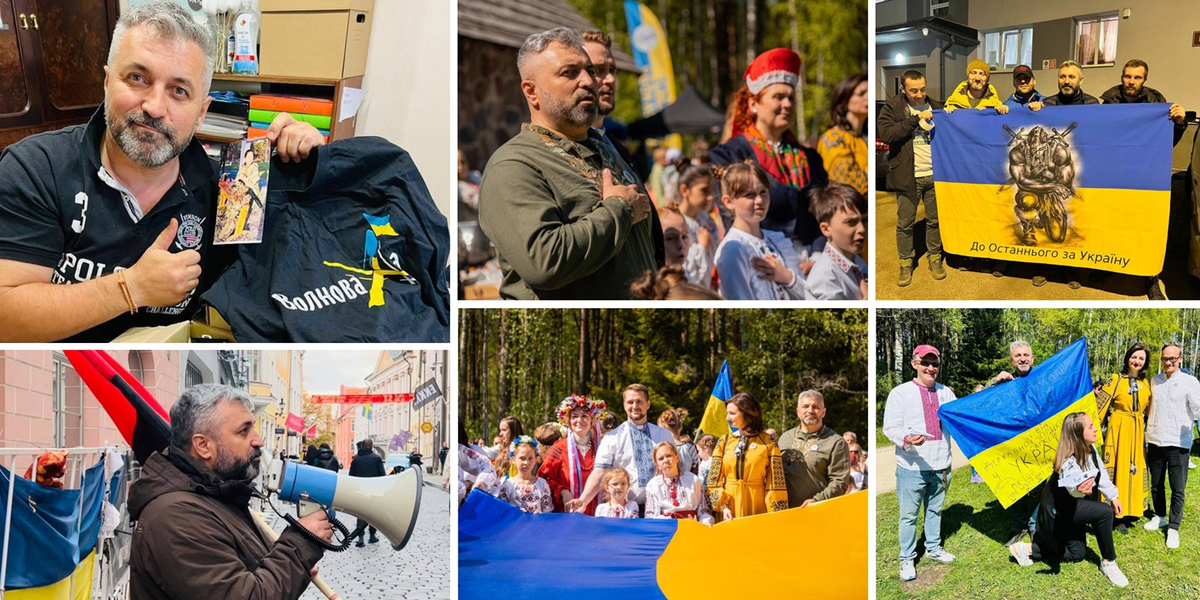
"So much blood has been shed for the freedom of Ukraine that the Ukrainian tree of freedom should be simply made of titanium." Interview with Volodymyr Palamar, Chairman of the Association of Ukrainian Organizations in Estonia.
"Ukrainian organizations not only exist in Estonia, Lithuania, and Latvia, but also in Finland, Sweden, Poland... The Ukrainian government and Ukrainian communities should leverage their opportunities for their development and recovery."
The Association of Ukrainian Organizations in Estonia, led by Volodymyr Palamar, an ethnic Ukrainian, advocates for the establishment of inter-municipal agreements between Estonian and Ukrainian communities. It aims to develop the Ukrainian language, culture, traditions, and identity while also providing support to the Armed Forces of Ukraine. The association purchases vehicles for the front lines and collects approximately 1 million euros per year in private donations.
In conversation with Volodymyr, one understands that with such support and love for Ukraine, victory is inevitable for us Ukrainians.
While Great Britain and France are debating whether Putin could potentially attack NATO countries, those from the NATO countries, which the Russian dictator has long declared as zones of his own interests, have been sounding the alarm for quite some time. Among them, Estonia stands out the most, with a 338 km border with the aggressor. The area of Estonia is 45 thousand square kilometers (for comparison: the area of Odesa Oblast is 33,000 sq. km, Kyiv Oblast – is 28,000 sq. km), and it has a population of only 1.3 million people, with almost a quarter of them being ethnic Russians. In terms of population density (28 people per square kilometer), Estonia ranks 188th in the world.
Recognizing that their country is only completely safe when Russian forces are occupied in Ukraine, the Estonian government has provided unprecedented assistance to the Ukrainian Ministry of Defense since the start of the full-scale invasion. According to the Estonian Embassy in Ukraine, the total amount of aid to Ukraine amounted to more than 1% of Estonian GDP. No other country in the world has given Ukraine so much from its own budget. Just recently, Prime Minister Kaia Kallas announced that Estonia plans to provide military support to Ukraine in the amount of 0.25% of GDP over the next 4 years.
1-euro bill
To a large extent, the allocation of such generous aid was contributed by the Ukrainians of Estonia. Before the full-scale war, about 28 thousand Ukrainians lived in the country - more than 2% of its population. However, they did not seek complete assimilation with Estonians; instead, they actively developed their own culture and preserved traditions, establishing several dozen of their own public organizations for this purpose. In 2000, these organizations merged into a single "umbrella" structure - the Association of Ukrainian Organizations of Estonia. It was headed in 2008 by Volodymyr Palamar, a native of Vinnytsia, who has been living in Tallinn for 35 years and has his own business.
The main goal of creating the association was dialogue with the Ministry of Culture, which has been involved in managing the integration processes among national minorities since the beginning of the 2000s. A powerful public structure was needed that could conduct a dialogue with all state structures on behalf of Ukrainians in Estonia. In 2009, Volodymyr Palamar, as the chairman of the board of the Association, became a member of the council under the Minister of Culture of Estonia for national minorities.
The second goal of the association was the preservation of Ukrainian culture, language, and traditions, taking into account the fact that Ukrainians are already part of Estonian society. Nonetheless, the association members considered the Ukrainian language as the main feature of Ukrainian national identity, an element that could prevent the complete dissolution of Ukrainians in Estonian society, which posed a serious threat given their ability to assimilate quickly. The third goal was to provide comprehensive assistance to Ukraine.
The scope and direction of this aid turned out to be significant, such that three months before the full-scale invasion, President of Ukraine Volodymyr Zelensky awarded Volodymyr Palamar with the Order of Merit of the III degree: "for a significant personal contribution to the development of the volunteer movement." At that time, the head of the Association of Ukrainian Organizations of Estonia already possessed the medal "For assistance to the Armed Forces of Ukraine" from the Ukrainian Ministry of Defense. This recognition was thanks to the aid provided to the Ukrainian army, including medical equipment for military hospitals, which Mr. Volodymyr brought to Ukraine several times, as well as NATO-style first-aid kits distributed to fighters of various Ukrainian volunteer battalions. Volodymyr Palamar's cousin served in one of these battalions and tragically lost his life in battles with the Russian invaders at the beginning of 2022. His son subsequently took his place in the Armed Forces of Ukraine.
Therefore, for Volodymyr Palamar, assisting the Ukrainian army was and remains a family affair. Many Ukrainians in Estonia found themselves in similar situations, with active, wounded, or deceased relatives who had served in the military. Consequently, as soon as the full-scale Russian invasion began, the amount of aid from their side increased tenfold.
"In February 2022, this office resembled an anthill," Mr. Volodymyr remarks, gesturing with his right hand to indicate the modest room in the northern suburbs of Tallinn, adorned with Ukrainian flags and a portrait of Taras Shevchenko on the wall. "Some people brought items, others sorted them, and still others packed and sent them to Ukraine. In front of this desk of mine, mountains of various items were constantly growing and disappearing: helmets, body armor, first-aid kits, medical supplies..."
Ordinary people brought warm clothes for refugees and money to the office. Over the past year, the association collected more than 1 million euros. These funds were used to purchase cars for the Ukrainian military, diesel generators, and other essential supplies. Donations ranged from as little as 1 euro to as much as 100,000 euros. People donated not only money but also computer equipment, furniture, and food products. On one occasion, Volodymyr Palamar went to purchase a car for the Armed Forces of Ukraine. The owner, upon learning the purpose of the vehicle, issued a symbolic bill for 1 euro instead of the asking price of 5,000 euros.
In the initial days of the Russian invasion, the association's office also established a headquarters for coordinating and assisting Ukrainian refugees. They were transported from the Ukrainian-Polish border and accommodated in hotels, and later assistance was provided to help them find employment. Prior to the full-scale invasion, many Ukrainian refugees had been employed in ship repair and shipbuilding plants in Mariupol, Mykolaiv, and Kherson. They chose Estonia knowing they could find work there in their field. Volunteers from the Association of Ukrainian Organizations filled out documents for them in Estonian, provided contacts of relevant employers, and provided translations as needed.
Estonia, being a small country, had never before received such a large number of migrants simultaneously, making the assistance of Ukrainian public structures invaluable to its government. Various non-standard challenges emerged. For instance, it was discovered that some refugees with Ukrainian passports had arrived in Estonia from Russia. These individuals had been residing in Russia for an extended period and seized the opportunity to relocate westward. It became evident that such refugees couldn't be treated the same as those fleeing from Ukraine. The association consistently acted as an advisor to government officials during the adjustment of such processes.
Why do weekend schools need banduras?
None of the more than 30 permanent workers at the association receives a salary. Moreover, if necessary, the number of head office employees doubles or even triples. According to Mr. Volodymyr, this approach fully embodies the free Cossack spirit and allows them to focus exclusively on the most engaging projects. However, unpaid work also has its drawbacks: if a particular project—even if it is crucial—is not interesting to the organizational core, it may have to be abandoned. Volodymyr Palamar also admits that when he agreed to the position of chairman of the association in 2008, he didn't expect that this entirely unpaid work would consume 70% of his time. But now, during the war, that's precisely what's happening.
In 2023, the workload didn't decrease. Many residents of Estonia included donations to the association's accounts as part of their regular monthly expenses, which are directed towards the needs of the Ukrainian army.
The needs of Ukrainians who have found refuge from the war in Estonia extend beyond housing issues. The association brings a piece of Ukraine to them through various cultural projects. In May 2023, an ethno-festival of Ukrainian culture titled "Vyshyvanka Unites" was held for World Vyshyvanka Day. It was remarkable in its scale and beauty, serving as a celebration of the union of two peoples through a shared love of art, folk creativity, and traditions. Hence, the motto of the event was the slogan: "Different enriches, and common unites"! This event aimed to unite Ukrainians and Estonians in their desire to preserve ancient folk traditions and culture while introducing each other to their ethnic group and national cultural heritage. During the festival, a record was set, entering the Book of National Records of Ukraine: "the largest number of people in embroidered dresses in the Baltic countries" gathered in the open air at the Tallinn Museum. "Vyshyvanka" brought together the best local specialists in Ukrainian cuisine, talented craftsmen, singers, and dancers. Overall, in 2023, the Association of Ukrainian Organizations of Estonia spent more than 200,000 euros on the organization of cultural projects.
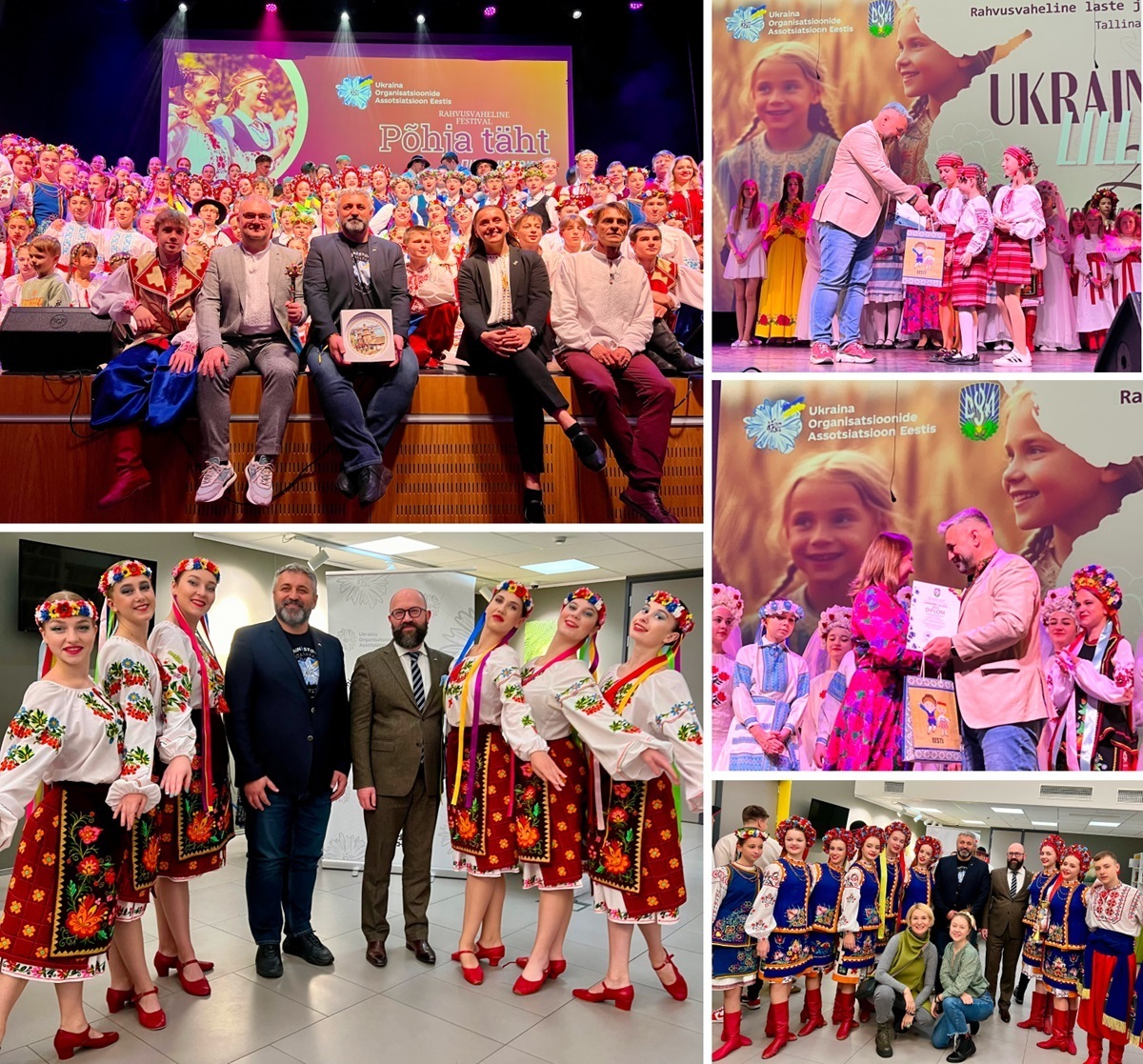
Festivals of children's creativity
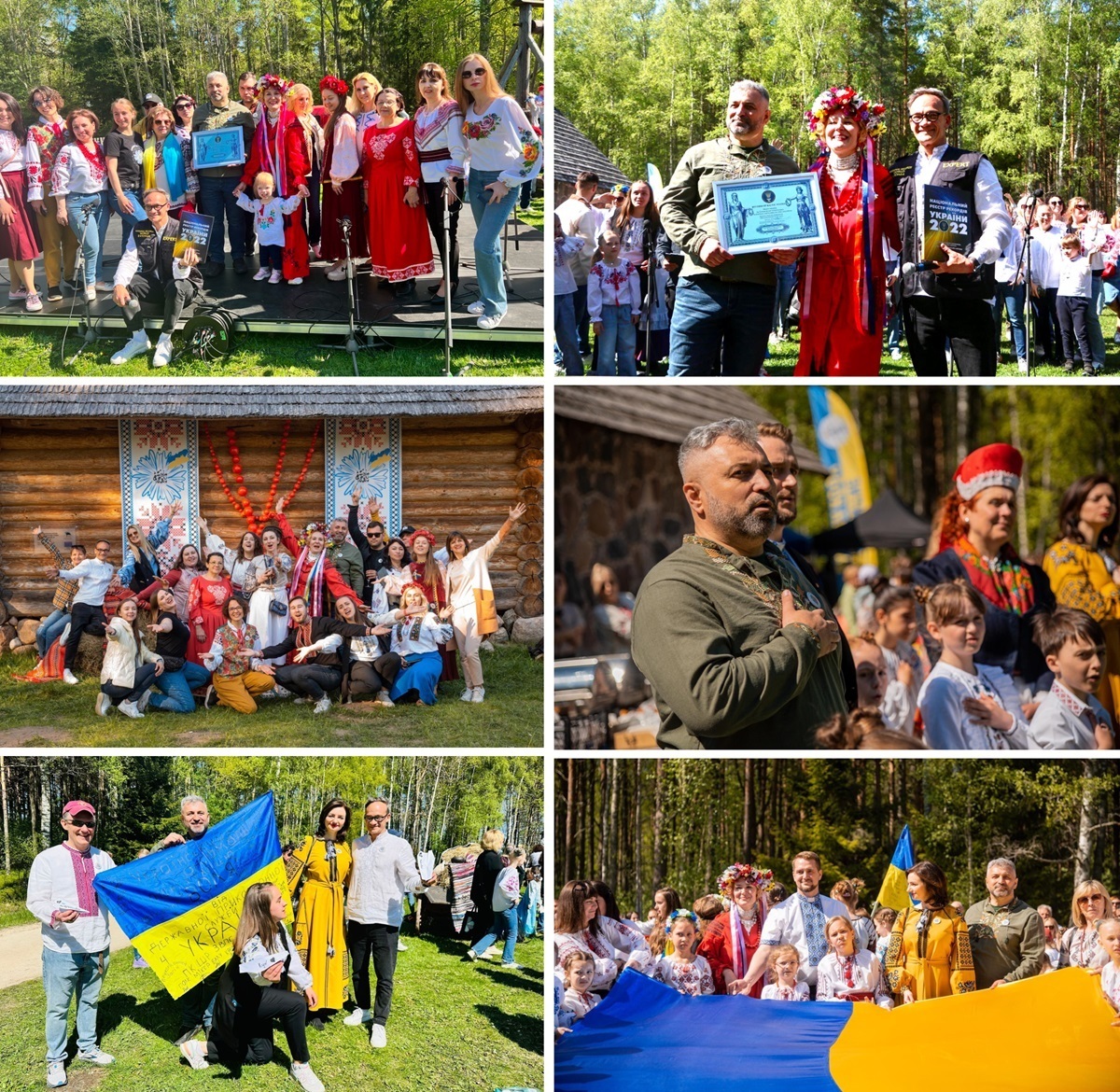
Festival "Embroidery unites"
The pride of the association lies in the Ukrainian weekend schools, which operate with the support of the Ministry of Education of Estonia. One of them, located in the capital, is headed by Volodymyr Palamar himself, and it was visited by the First Lady of Ukraine, Olena Zelenska, in 2019 during her husband's official visit to Tallinn. Following this visit, the Estonian network of Ukrainian schools received textbooks from the Embassy of Ukraine in Estonia. Subsequently, textbooks were also provided by the Ukrainian Greek Catholic Church and the Orthodox Church of Ukraine.
Ukrainian Member of Parliament Iryna Konstankevych also made a valuable contribution to the Tallinn school by gifting several banduras for the ensemble of the weekend school "Nadia". Now, the bandura ensemble is popular throughout Estonia, as the bandura is a very unusual and therefore intriguing instrument.
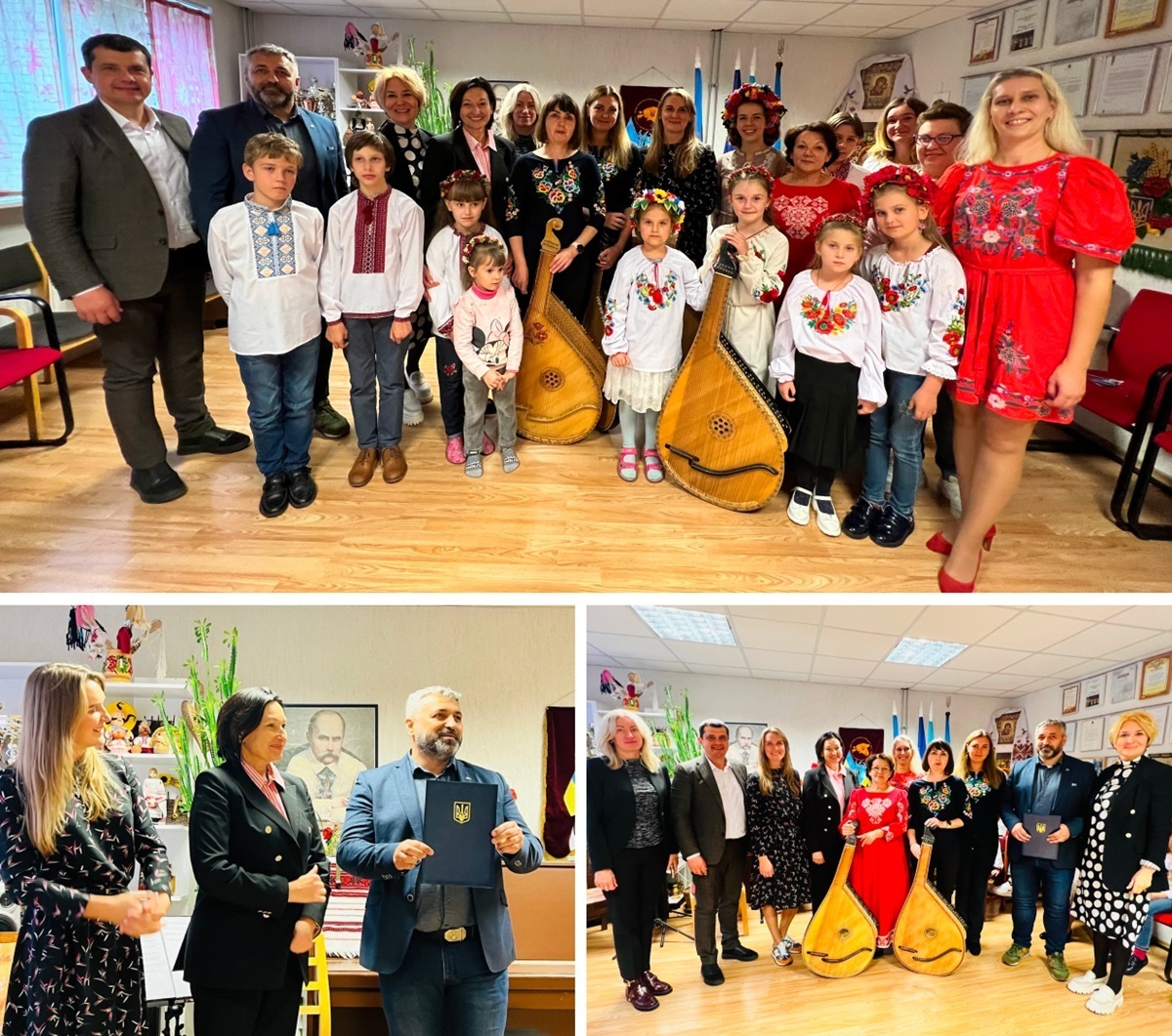
People's Deputy Irina Kostankevich gave the ensemble "Hope" bandura
Ukrainian weekend schools serve as the foundation for hosting annual large international festivals, with 600-700 children from Ukraine attending at the association's expense. Volodymyr Palamar considered such trips very important because they allowed Estonian Ukrainians, many of whom were born in Estonia, to interact with "Ukrainian Ukrainians," who are native speakers.
Ukrainians are the third largest national community in Estonia
Due to war-induced migration, the number of ethnic Ukrainians in Estonia, including those with residence permits and passports from other countries, has reached 130,000, which accounts for 10% of the country's population. Among them, 69,000 (including 20,000 pensioners and 16,000 children) are "military" refugees. As a result, the third largest Ukrainian diaspora in Estonia has quadrupled. Consequently, the Association needed to create more integration, social, and cultural projects to foster closer communication between Ukrainians and their integration into Estonian society.
"Until 2014, the majority of Estonian citizens categorized the population of their state into Estonians and Russian speakers," says Volodymyr Palamar. "Throughout that time, our association advocated for the recognition that Ukrainians are not Russians; they are a separate nation with their own language." Despite there being a program called "Chervona Kalyna" on Estonian state radio, where only one hour of airtime per week is dedicated to Ukrainian content, I believe this is insufficient for the third largest national minority. Therefore, I am determined to increase our presence on Estonian state media." A significant achievement was the opening of volunteer radio, DRUZI.ee, in November 2023. Currently, the radio broadcasts Ukrainian music of all genres, from popular songs to rock and folk. Plans are underway to expand the content to include news and a network of programs that will provide Ukrainians access to objective and independent information, aid their integration into Estonian society, and enhance dialogue between Ukrainian and Estonian communities. The project is currently self-financed, but they hope for support from European grants. Palamar sees the establishment of Ukrainian-language radio in Estonia as a model for creating Ukrainian media in other European countries, convinced that Ukraine's accession to the European Union is on the horizon.
Local Russians, accustomed to being the predominant national minority in the country, reacted sensitively to the growing role of Ukrainians in Estonia. In some instances, Ukrainians even encountered domestic conflicts with Russians in certain companies, as their numbers decreased. The Russian-speaking Estonian press, some of which Palamar believes is controlled by the Kremlin, exacerbated Russian dissatisfaction. The Association of Ukrainian Organizations always endeavors to respond to all press statements that in any way affect the interests of Ukraine.
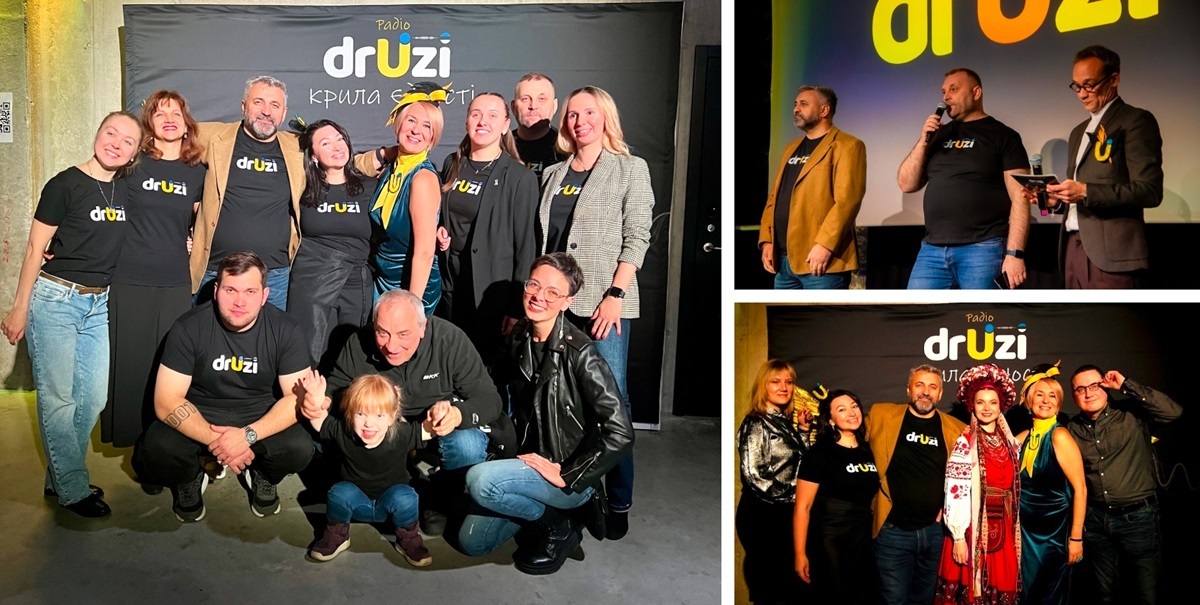
Opening Radio Friends
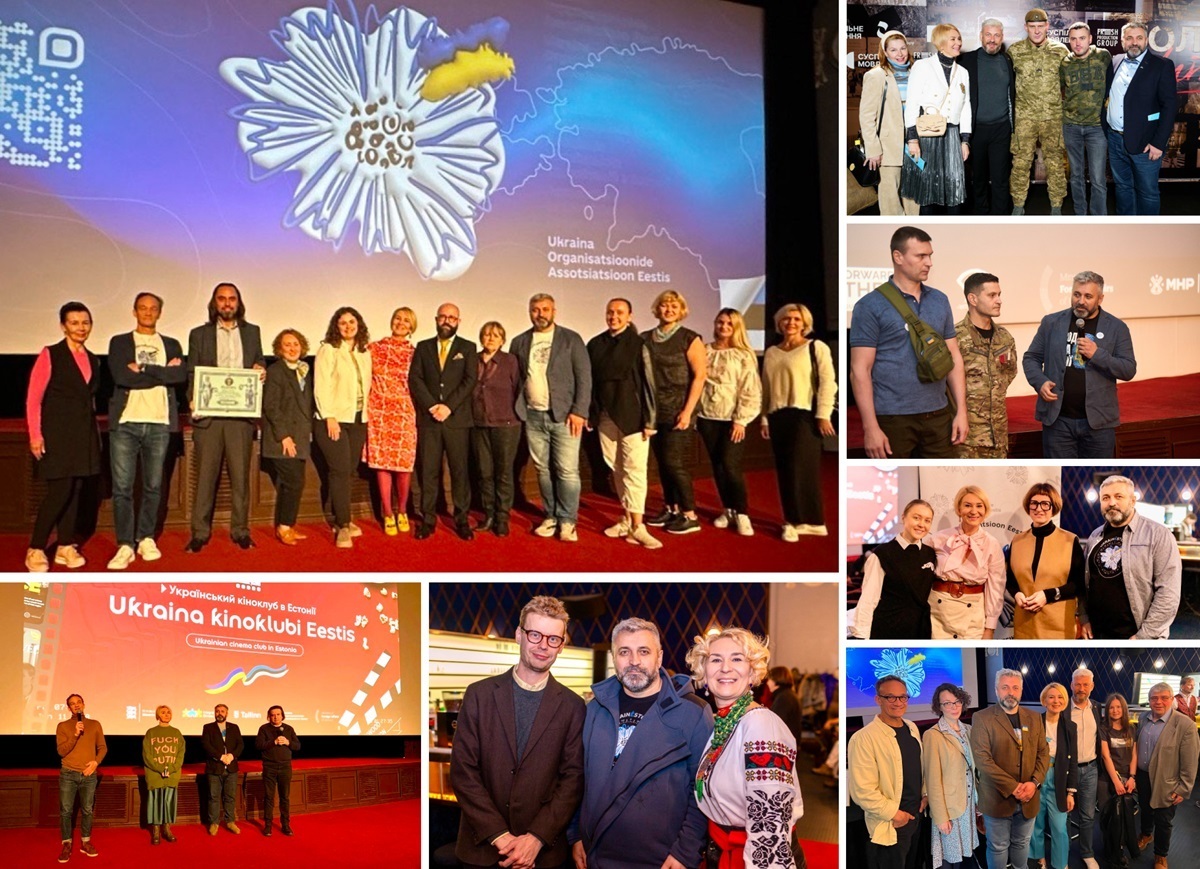
The Association established the Ukrainian Film Club in Estonia in February 2023
Volodymyr Palamar is deeply troubled by the fact that Russian-speaking Estonian mass media often refrain from calling the conflict in Ukraine a war. "For them, it's just a 'conflict,' 'something happened between Russians and Ukrainians,'" he laments. "We must address this issue." The association actively brings attention to the editors of specific publications, highlighting the inappropriateness of emphasizing the nationality of various criminals. Previously, such media outlets were inclined to report on incidents involving individuals with Ukrainian backgrounds, such as "a drunk Ukrainian riding a trolleybus," "a Ukrainian woman pushing a person in a queue," or "a Ukrainian man begging near the ferry" (although, in reality, the person in question might not have been Ukrainian at all, despite holding a Ukrainian passport). Such portrayals amount to outright Nazism and a violation of human rights. "We even complained to the Chancellor of Justice of Estonia, demanding scrutiny of biased materials about Ukrainians. Eventually, our efforts bore fruit, as the tone of Russian-language mass media began to change." Interestingly, ordinary Estonians often respond to such Russian narratives by recalling Soviet repressions, the suppression of the Estonian language, and how Estonians in exile established their own mass media to safeguard their language and culture. For Estonians, their historical memory serves as a guarantee of their current support for Ukraine.
A Bag of Socks from the Island of Saaremaa
Volodymyr Palamar has personal grievances against Russia, stemming from his family's experiences of repression. "Part of my family was executed during the Soviet era, while the rest were exiled to Krasnoyarsk Krai, and were not allowed to return to their homeland even after official rehabilitation."
Estonian families also harbor memories of the "benefits" of Soviet occupation. Among the most poignant donations received was a large bag of socks knitted by a ninety-year-old Estonian grandmother residing on the island of Saaremaa in the Baltic Sea. Accompanying the parcel was a letter in which she recounted how, as a young girl, she and her family were deported to Siberia by Soviet authorities. She survived thanks to the help of Ukrainians, who had already adapted to life in Siberian camps since the 1920s. These Ukrainians willingly assisted the Baltic deportees, who were sent to the depths of Russia after World War II for alleged collaboration with fascists. Thus, in exile, a Ukrainian woman knitted warm socks for a fragile Estonian girl, and this gesture of kindness remained etched in her memory throughout her life. She was overjoyed to see photos of Ukrainian fighters wearing the socks she had knitted, which Volodymyr Palamar later shared with her.
Deja vu 1939: How the USSR "Liberated" Estonia from Itself:
On September 29, 1939, Kliment Voroshilov, the People's Commissar of Defense of the USSR, declared that "the Red Army is prepared to deliver a powerful and decisive blow against the Estonian army." At that time, 160,000 Soviet soldiers, equipped with 700 guns, 600 tanks, and 600 aircraft, were stationed along the Russian-Estonian border. To justify the invasion, the Soviet submarine Sh-303 unsuccessfully launched torpedoes at the Soviet merchant ship Metalist, which was later rammed and sunk by a Soviet Navy destroyer. The Soviet authorities blamed "an unknown submarine based on Estonian territory" for the incident. On June 16, 1940, the Soviet Union presented an ultimatum to the Estonian government, accusing it of "aggressive intentions." The ultimatum demanded the immediate inclusion of "politicians friendly to the Soviet Union" in the Estonian government and official permission for the introduction of Soviet troops. This ultimately led to the transformation of the independent state into the Estonian SSR on August 6, 1940, which was incorporated into the Soviet Union as a "new happy republic freed from the oppression of landlords and capitalists."
It is the preservation of national memory that shapes the government's policy regarding conflicts based on nationality. For instance, in September 2022, a Russian man who insulted Ukrainian women on Pirita beach in Tallinn due to the Ukrainian language they spoke had his long-term residence permit revoked under the Estonian Law on Foreigners. The application of the well-known algorithm "suitcase - station - Russia" has unsettled many Russians in Estonia, who are now attempting to suppress their dissatisfaction with Ukrainians and their language.
"If you are, as they say here, an Estonian citizen, meaning you reside permanently in Estonia, you must adhere to European values and be tolerant of other peoples and cultures," Volodymyr Palamar asserts. "You are welcome to develop your own culture but do not obstruct others from doing the same. This caveat applies doubly to Russians, whose country waged a genocidal war against a significant European nation. Every Russian, to some extent, is implicated in this war and will bear this shame for many years to come." Today, Russian culture on the global stage is associated with aggression. Moreover, it serves as a tool through which the Kremlin promotes its divisive narratives, such as an "existential" war with the West, false claims of Ukraine attacking Russia, and notions of Nazis and "fighters" within the Ukrainian army. Consequently, many Russian public organizations in Estonia were established under the directives and funding of Moscow, aimed at bolstering propaganda efforts. However, in practice, they are unsustainable. Nevertheless, numerous Russian-speaking residents in Estonia, particularly those near the Russian border, readily embrace the delusions propagated by such entities. They continue to consume Russian media and subscribe to false beliefs, such as the absurd notion that Ukrainians consume Russian children.
"Ukrainians are not a problem for us, Ukrainians are a potential for us," asserts Volodymyr Palamar
According to him, the Estonian government highly values Ukrainian migrants, who demonstrate a strong work ethic, responsibility, and seamless integration into any team. Ukrainians have effectively filled the labor gap, and their sudden departure would significantly impact Estonia's economy. In fact, thanks to Ukrainian migrants, the state budget has seen a notable increase in revenue compared to the previous year. In 2023, the revenue was projected at 15.6 billion euros, whereas in 2024, it rose to 16.8 billion euros.
As a result, the Estonian government actively supports Ukrainian refugees by providing various forms of assistance, including financial aid, food assistance, and partial compensation for housing rent, along with bridging the gap between Estonian and Ukrainian pensions. Many Ukrainians, having lost everything due to the war, have nowhere else to go, as their hometowns lie in ruins or are under Russian occupation. For those wishing to remain in Estonia, the government requires a firm commitment: they must learn the Estonian language through special courses, understand Estonian legislation and history, secure employment, adhere to local regulations, and not be a burden on the state.
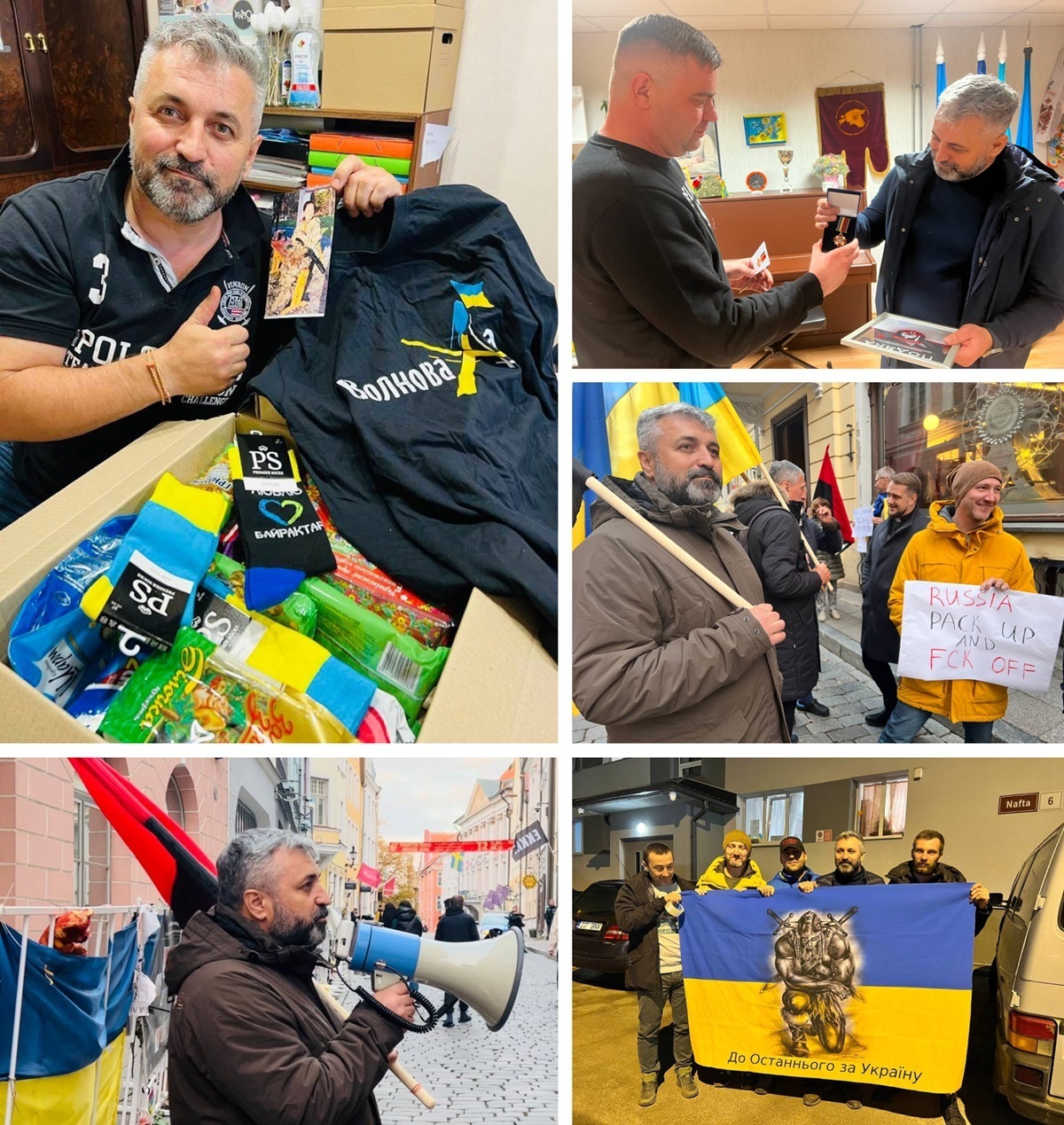
Rallies in support of Ukraine, awarding to volunteers
Signing a memorandum with Lesya Ukrainka's university in Lutsk
"Our countries share a common plight, both having the same troublesome neighbor," remarks Volodymyr Palamar. "This is why Estonians empathize with Ukrainians." He finds solace in the words of an Estonian who once said to him, "Ukrainians are not a problem for us, Ukrainians are an asset for us." Estonia, as a member state of the European Union, upholds fundamental values, including freedom of choice. Therefore, when a person, amid adversity, chooses to stay, it is reason enough for the average Estonian to embrace them as one of their own and assist them in adapting to life in their new homeland. Nevertheless, most Ukrainians yearn to return home, a sentiment evident among the children attending Ukrainian schools in Estonia. However, with each passing year, the connection to Ukraine weakens.
Public diplomacy is a significant aspect of the Association of Ukrainian Organizations of Estonia's work. This involves facilitating the signing of various cooperation agreements at the municipal level, such as those between Kyiv and Tallinn, and Ternopil and Viljandi, sister cities respectively. However, not all such agreements materialize into tangible outcomes; success depends on the dedication of the teams involved. The association receives numerous requests from Ukrainian communities seeking cooperation with regions in Estonia.
Volodymyr Palamar cites the exemplary cooperation between the Estonian city of Yihvi and the Lipovets community in the Vinnytsia region. The association played a pivotal role in fostering this partnership, resulting in mutual exchanges and support, particularly evident during the full-scale war when Yihvi provided essential supplies for local territorial defense.
"In Estonia, we're like 'amateur' Ukrainians," jests Volodymyr Palamar about the national "status." Living in exile inevitably transforms one's identity, yet maintaining a connection with the historical homeland remains crucial for emigrants. He emphasizes the significance of the Ukrainian diaspora worldwide, urging both the Ukrainian government and communities to leverage their collective potential for development and recovery. He concludes with a reflection on Ukraine's resilience and the indomitable spirit of its people, expressing pride in being part of this enduring force.
Author: Dmytro Sinyak
